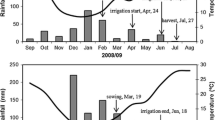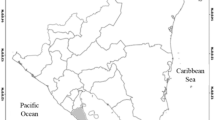Abstract
Chickpea (Cicer arietinum L.) is a very important legume crop mainly due to its nutritional properties, being cultivated in several countries. However, parameters on water consumption and crop coefficient (Kc) are limited by cultivar for irrigation management. Thus, this study aimed to determine the water requirements and Kc for three chickpea cultivars. The crop reference evapotranspiration (ETo) was estimated using the Penman–Monteith method with meteorological data recorded inside the greenhouse. Crop evapotranspiration (ETc) was obtained by weighing minilysimeters and soil moisture sensors. The Kc was determined by the ETc/ETo ratio. The chickpea cultivars evaluated were Cícero, BRS Aleppo, and BRS Cristalino. The average ETc throughout the cycle was 4.5, 4.1, and 4.5 mm days−1 for cultivars Cícero, BRS Aleppo, and BRS Cristalino, respectively. The average ETc for the respective cultivars was 2.3, 2.5, and 2.4 mm days−1 in the initial phase, reaching 5.6, 4.5, and 5.4 mm days−1 in the crop phase of growth. The Kc values ranged from 0.38 to 1.00 for Cícero, 0.39 to 0.80 for BRS Aleppo, and 0.38 to 0.95 for BRS Cristalino. The cultivar Cícero showed higher Kc and higher water demand. The cultivar BRS Aleppo was the one with the lowest Kc and water demand, but longer duration of maximum value due to indeterminate growth habit. The variation in Kc correlated positively with the leaf number and crop phases patterns. This demonstrates the importance of determining Kc to increase efficiency in irrigation management by cultivar instead of adopting generalized Kc values.







Similar content being viewed by others
Abbreviations
- ETo:
-
Reference evapotranspiration
- ETc:
-
Crop evapotranspiration
- Kc:
-
Crop coefficient
- FAO:
-
Food and Agriculture Organization
- EMBRAPA:
-
Brazilian Agricultural Research Corporation
- FC:
-
Field capacity
- PWP:
-
Permanent wilting point
- DAP:
-
Days after planting
References
Allen RG, Pereira LS, Raes D, Smith M (1998) Crop evapotranspiration—guidelines for computing crop water requirements. In: FAO Irrigation and drainage paper 56. Food and Agriculture Organization of the United Nations, Rome
Alvares CA, Stape JL, Sentelhas PC et al (2013) Köppen’s climate classification map for Brazil. Meteorol Z. https://doi.org/10.1127/0941-2948/2013/0507
Anapalli SS, Ahuja LR, Gowda PH et al (2016) Simulation of crop evapotranspiration and crop coefficients with data in weighing lysimeters. Agric Water Manag 177:274–283. https://doi.org/10.1016/j.agwat.2016.08.009
Anapalli SS, Fisher DK, Reddy KN et al (2019) Modeling evapotranspiration for irrigation water management in a humid climate. Agric Water Manag 225:105731. https://doi.org/10.1016/j.agwat.2019.105731
Anapalli SS, Fisher DK, Pinnamaneni SR, Reddy KN (2020) Quantifying evapotranspiration and crop coefficients for cotton (Gossypium hirsutum L.) using an eddy covariance approach. Agric Water Manag 233:106091. https://doi.org/10.1016/j.agwat.2020.106091
Antunes Júnior EDJ, Alves Júnior J, Casaroli D (2018) Calibração do sensor capacitivo EC-5 em um latossolo em função da densidade do solo. Reveng 26:80–88. https://doi.org/10.13083/reveng.v26i1.864
Artiaga OP, Spehar CR, Boiteux LS, Nascimento WM (2015) Avaliação de genótipos de grão de bico em cultivo de sequeiro nas condições de Cerrado - DOI:10.5039/agraria.v10i1a5129. Revista Brasileira de Ciências Agrárias (Agrária) 10:102–109
Bartlett MK, Klein T, Jansen S et al (2016) The correlations and sequence of plant stomatal, hydraulic, and wilting responses to drought. PNAS 113:13098–13103. https://doi.org/10.1073/pnas.1604088113
Contreras JI, Alonso F, Cánovas G, Baeza R (2017) Irrigation management of greenhouse zucchini with different soil matric potential level. Agronomic and environmental effects. Agric Water Manag 183:26–34. https://doi.org/10.1016/j.agwat.2016.09.025
de Giordano LB, Nascimento WM (2005) Grão-de-bico Cícero, Sabor e qualidade
de Camargo AC, Favero BT, Morzelle MC et al (2019) Is chickpea a potential substitute for soybean? Phenolic bioactives and potential health benefits. Int J Mol Sci 20:2644. https://doi.org/10.3390/ijms20112644
de Medeiros GA, Arruda FB, Sakai E, Fujiwara M (2001) The influence of crop canopy on evapotranspiration and crop coefficient of beans (Phaseolus vulgaris L.). Agric Water Manag 49:211–224. https://doi.org/10.1016/S0378-3774(00)00150-5
de Sousa DP, Fernandes TFS, Tavares LB et al (2021) Estimation of evapotranspiration and single and dual crop coefficients of acai palm in the Eastern Amazon (Brazil) using the Bowen ratio system. Irrig Sci 39:5–22. https://doi.org/10.1007/s00271-020-00710-2
Doorenbos J, Pruitt WO (1977) Guidelines for predicting crop water requirements. Rev. Food and Agriculture Organization of the United Nations, Rome
Evett S, Howell T, Schneider AD et al (2015) The bushland weighing lysimeters: a quarter century of crop et investigations to advance sustainable irrigation. Trans ASABE 58:163–179. https://doi.org/10.13031/trans.58.11159
Fares A, Polyakov V (2006) Advances in crop water management using capacitive water sensors. Advances in agronomy. Academic Press, New York, pp 43–77
Gao Z, Wang Y, Tian G et al (2020) Plant height and its relationship with yield in wheat under different irrigation regime. Irrig Sci 38:365–371. https://doi.org/10.1007/s00271-020-00678-z
Gaur PM, Tripathi S, Gowda CLL, et al. (2010) Chickpea seed production manual Patancheru 502324, Andhra Pradesh, India: International Crops Research Institute for the Semi-Arid Tropics. p 28
Ghoulem M, El Moueddeb K, Nehdi E et al (2019) Greenhouse design and cooling technologies for sustainable food cultivation in hot climates: review of current practice and future status. Biosys Eng 183:121–150. https://doi.org/10.1016/j.biosystemseng.2019.04.016
Gong X, Qiu R, Sun J et al (2020) Evapotranspiration and crop coefficient of tomato grown in a solar greenhouse under full and deficit irrigation. Agric Water Manag 235:106154. https://doi.org/10.1016/j.agwat.2020.106154
Hoskem BCS, da Costa CA, Nascimento WM et al (2017) Produtividade e qualidade de sementes de grão-de-bico no Norte de Minas Gerais. Revista Brasileira de Ciências Agrárias (Agrária) 12:261–268. https://doi.org/10.5039/agraria.v12i3a5445
Justino LF, Alves Júnior J, Battisti R et al (2019) Assessment of economic returns by using a central pivot system to irrigate common beans during the rainfed season in Central Brazil. Agric Water Manag 224:105749. https://doi.org/10.1016/j.agwat.2019.105749
Kale H, Kaplan M, Ulger I et al (2018) Feed value of maize (Zea mays var. indentata (Sturtev.) L.H. Bailey) grain under different irrigation levels and nitrogen doses. Turk J Field Crops. https://doi.org/10.17557/tjfc.421974
Kaplan M, Karaman K, Kardes YM, Kale H (2019) Phytic acid content and starch properties of maize (Zea mays L.): effects of irrigation process and nitrogen fertilizer. Food Chem 283:375–380. https://doi.org/10.1016/j.foodchem.2019.01.029
Kashiwagi J, Krishnamurthy L, Purushothaman R et al (2015) Scope for improvement of yield under drought through the root traits in chickpea (Cicer arietinum L.). Field Crop Res 170:47–54. https://doi.org/10.1016/j.fcr.2014.10.003
Libardi LGP, de Faria RT, Dalri AB et al (2019) Evapotranspiration and crop coefficient (Kc) of pre-sprouted sugarcane plantlets for greenhouse irrigation management. Agric Water Manag 212:306–316. https://doi.org/10.1016/j.agwat.2018.09.003
López-Urrea R, Sánchez JM, de la Cruz F et al (2020) Evapotranspiration and crop coefficients from lysimeter measurements for sprinkler-irrigated canola. Agric Water Manag 239:106260. https://doi.org/10.1016/j.agwat.2020.106260
Lozano CS, Rezende R, de Freitas PSL et al (2017) Estimatation of evapotranspiration and crop coefficient of melon cultivated in protected environment. Revista Brasileira de Engenharia Agrícola e Ambiental 21:758–762. https://doi.org/10.1590/1807-1929/agriambi.v21n11p758-762
Marin FR, Angelocci LR, Nassif DSP et al (2016) Crop coefficient changes with reference evapotranspiration for highly canopy-atmosphere coupled crops. Agric Water Manag 163:139–145. https://doi.org/10.1016/j.agwat.2015.09.010
Martins JD, Rodrigues GC, Paredes P et al (2013) Dual crop coefficients for maize in southern Brazil: model testing for sprinkler and drip irrigation and mulched soil. Biosyst Eng 115:291–310. https://doi.org/10.1016/j.biosystemseng.2013.03.016
Meirelles ML, Franco AC, Farias SEM, Bracho R (2011) Evapotranspiration and plant–atmospheric coupling in a Brachiaria brizantha pasture in the Brazilian savannah region. Grass Forage Sci 66:206–213. https://doi.org/10.1111/j.1365-2494.2010.00777.x
Mohammed A, Tana T, Singh P et al (2017) Identifying best crop management practices for chickpea (Cicer arietinum L.) in Northeastern Ethiopia under climate change condition. Agric Water Manag 194:68–77. https://doi.org/10.1016/j.agwat.2017.08.022
Moraes DHM, Casaroli D, Evangelista AWP et al (2019) Determination of basal temperature and its relationship with Jatropha crop in irrigated and non-irrigated system. J Agric Sci 11:p465. https://doi.org/10.5539/jas.v11n2p465
Nascimento WM, Artiaga OP, Boiteux LS, et al. (2014) BRS Aleppo: grão de bico. Maior tolerância a fungos de solo. In: Hortaliças Leguminosas. Embrapa Hortaliças, Brasília, pp. 01–04
Nascimento WM, Suinaga FA, Boiteux LS, et al (2017) BRS Cristalino: grão de bico. Nova cultivar de grão-de-bico de dupla aptidão
Odhiambo LO, Irmak S (2012) Evaluation of the impact of surface residue cover on single and dual crop coefficient for estimating soybean actual evapotranspiration. Agric Water Manag 104:221–234. https://doi.org/10.1016/j.agwat.2011.12.021
Ometto JC (1981) Bioclimatología vegetal, 1st edn. Agronomica Ceres, São Paulo
Pendergast L, Bhattarai SP, Midmore DJ (2019) Evaluation of aerated subsurface drip irrigation on yield, dry weight partitioning and water use efficiency of a broad-acre chickpea (Cicer arietinum L.) in a vertosol. Agric Water Manag 217:38–46. https://doi.org/10.1016/j.agwat.2019.02.022
Rodrigues TR, Vourlitis GL, de Lobo FA et al (2014) Seasonal variation in energy balance and canopy conductance for a tropical savanna ecosystem of south central Mato Grosso, Brazil. J Geophys Res Biogeosci 119:1–13. https://doi.org/10.1002/2013JG002472
Saeidi R, Ramezani Etedali H, Sotoodehnia A et al (2021) Salinity and fertility stresses modify Ks and readily available water coefficients in maize (case study: Qazvin region). Irrig Sci. https://doi.org/10.1007/s00271-020-00711-1
Soltani A, Robertson MJ, Torabi B et al (2006) Modelling seedling emergence in chickpea as influenced by temperature and sowing depth. Agric For Meteorol 138:156–167. https://doi.org/10.1016/j.agrformet.2006.04.004
Talebnejad R, Sepaskhah AR (2015) Effect of deficit irrigation and different saline groundwater depths on yield and water productivity of quinoa. Agric Water Manag 159:225–238. https://doi.org/10.1016/j.agwat.2015.06.005
Urban J, Ingwers MW, McGuire MA, Teskey RO (2017) Increase in leaf temperature opens stomata and decouples net photosynthesis from stomatal conductance in Pinus taeda and Populus deltoides x nigra. J Exp Bot 68:1757–1767. https://doi.org/10.1093/jxb/erx052
Vilela MDS, Cabral Filho FR, Teixeira MB et al (2015) ACURÁCIA DE UM MINI-LISÍMETRO DE PESAGEM ELETRÔNICA DE BAIXO CUSTO. R_I 1:158–167. https://doi.org/10.15809/irriga.2015v1n2p158
Wang Y, Cai H, Yu L et al (2020) Evapotranspiration partitioning and crop coefficient of maize in dry semi-humid climate regime. Agric Water Manag 236:106164. https://doi.org/10.1016/j.agwat.2020.106164
Wei Z, Paredes P, Liu Y et al (2015) Modelling transpiration, soil evaporation and yield prediction of soybean in North China Plain. Agric Water Manag 147:43–53. https://doi.org/10.1016/j.agwat.2014.05.004
Wijewardana C, Reddy KR, Bellaloui N (2019) Soybean seed physiology, quality, and chemical composition under soil moisture stress. Food Chem 278:92–100. https://doi.org/10.1016/j.foodchem.2018.11.035
Xu G, Xue X, Wang P et al (2018) A lysimeter study for the effects of different canopy sizes on evapotranspiration and crop coefficient of summer maize. Agric Water Manag 208:1–6. https://doi.org/10.1016/j.agwat.2018.04.040
Acknowledgements
The authors would like to thank the Federal Institute of Goiás-Campus Ceres (IF Goiano) and to the School of Agronomy of the Federal University of Goiás (UFG) for the infrastructure, support, and inputs made available. To the Brazilian Agricultural Research Corporation (EMBRAPA) for the concession of seeds, to Bristom Inc. for the equipment and technical support, and to everyone who contributed to this research.
Author information
Authors and Affiliations
Corresponding author
Ethics declarations
Conflict of interest
On behalf of all authors, the corresponding author states that there is no conflict of interest.
Additional information
Publisher's Note
Springer Nature remains neutral with regard to jurisdictional claims in published maps and institutional affiliations.
Supplementary Information
Below is the link to the electronic supplementary material.
Rights and permissions
About this article
Cite this article
Silva, K.F., de Moraes, D.H.M., Mesquita, M. et al. Water requirement and crop coefficient of three chickpea cultivars for the edaphoclimatic conditions of the Brazilian savannah biome. Irrig Sci 39, 607–616 (2021). https://doi.org/10.1007/s00271-021-00737-z
Received:
Accepted:
Published:
Issue Date:
DOI: https://doi.org/10.1007/s00271-021-00737-z




